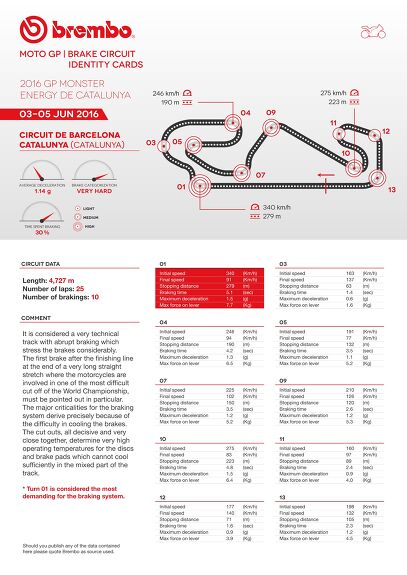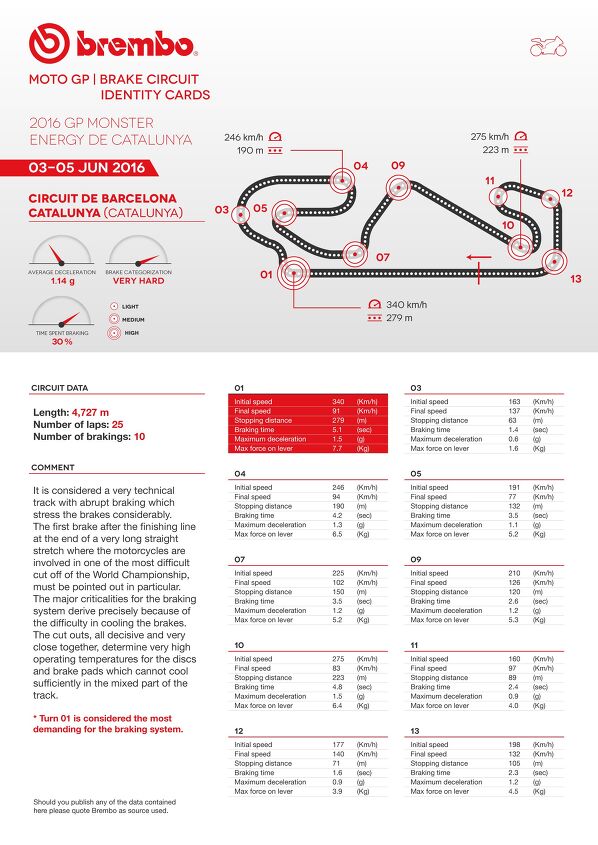Brembo Analyzes MotoGP Brake Statistics At Barcelona
The Circuit de Barcelona-Catalunya will host the seventh race of the 2016 MotoGP World Championship, June 3-5. The track was inaugurated on September 10, 1991 and has hosted the premium class World Championship races since 1996.
The 2.93-mile (4,727-meter) long circuit comprises eight right-handed curves, five left-handed curves and a main straightaway measuring over a half-mile (1,047 meters). This straightaway will enable the fastest bikes to reach 217 mph (350 km/h) on this track for the first time. Indeed the speeds are incredibly high, but fortunately this year every single rider in the MotoGP is equipped with Brembo brakes.
The cut-outs are decisive and very close together resulting in very high operational temperatures for the Brembo carbon discs and pads, which remain reliable even at temperatures that near 800 degrees. Just think: the pads used in the Brembo braking systems which are mounted on the most prestigious road super sports only get to a maximum of 752º F (400° C). All this combined with the temperature of the asphalt, which reached 120° F (49° C) in last year’s race, makes cooling the brakes on this track more difficult than average.
According to Brembo technicians, the Circuit de Barcelona-Catalunya falls into the category of tracks that is hardest on the brakes. On a scale of one to five, it earned a five on the difficulty index, a figure that none of the six tracks used thus far in the 2016 season have ever come close to. The same score however was given to the Motegi and Sepang circuits, where GP races will be held in the autumn.
Brake use during the GP
The Circuit de Barcelona-Catalunya is a highly technical track with abrupt stopping that demands a great deal from the brakes: in five of the curves, the riders reduce their speeds to under 62 mph (100 km/h). The 10 braking sections lead to the riders spending about 13 minutes total in braking during the entire race.
The average deceleration in the GP is equivalent to 1.14 g, which is much lower than what the F1 cars experience on the same circuit (the only difference is the presence of one more curve in the final stretch). But as we have already seen at the Austin GP (Formula 1 vs. MotoGP: Who Wins When Braking?) the deceleration the drivers and riders experience is consistent with the characteristics of the vehicle they are driving. Summing up all of the force applied by a rider on the lever throughout the GP race, the result exceeds 2,645 lbs. (1200 kilograms), which is equivalent to 170 whole Iberian hams.
The most challenging stops
Of the 10 braking sections in the Circuit de Barcelona-Catalunya, only one is classified as very difficult on the brakes, but seven are of medium-difficulty and two are light. The braking section at the Elf curve (Turn 1) is considered one of the most difficult in the world because it is preceded by a straightaway that is more than one kilometer long. The bikes arrive at more than 211 mph (340 km/h) and the riders brake for 5.1 seconds applying a 7.7 kg load on the lever and 13.3 bar of pressure to take the curve at 56 mph (91 km/h). The most challenging of the mid-level difficulty curves is the Caixa (Turn 10) because deceleration reaches almost 124 mph (200 km/h) in just 731 feet (223 meters) and 4.8 seconds. In taking curve number 3, on the other hand, the riders get help from the brakes for only 1.4 seconds, the time required to go from 101 to 86 mph (163 to 137 km/h).
Brembo Victories
All of the 20 editions of the Catalunya GP were won by bikes with Brembo brakes: Honda won nine times, Yamaha eight, Ducati two and Suzuki one. Valentino Rossi was victorious 6 times in 500-MotoGP, however he has not won there since 2009. Instead, Jorge Lorenzo has won three of the last four races.
More by Press Release































Comments
Join the conversation